Less dramatically, of course, there are moments when you find a book or two that seem providentially to spur you on the path you are ambling.
Below are some such books I have recently acquired.
These first two are volumes 3 and 4 in the Bookman Translation Library. These aren't 珠寶 as much as they are little talismans of power and learning as I forge ahead on the path of mastering Chinese and, hopefully, using my language skills as a translator/evangelist now and in the future.
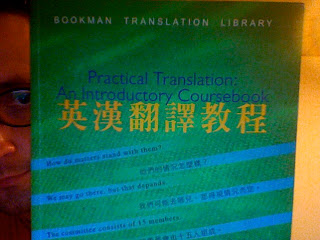 The first volume speaks for itself. Throughout the book there are small exercises designed to reinforce various skills and preempt various, and the penultimate 60 pages or so of the text are excerpts from English books and stories. These are "exercises for the reader" and Chinese translations are provided at the very end of the book (in the ultimate 60 pages or so).
The first volume speaks for itself. Throughout the book there are small exercises designed to reinforce various skills and preempt various, and the penultimate 60 pages or so of the text are excerpts from English books and stories. These are "exercises for the reader" and Chinese translations are provided at the very end of the book (in the ultimate 60 pages or so).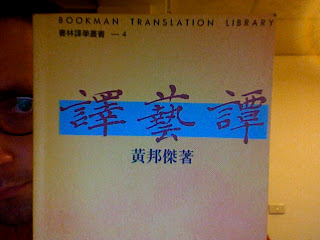 The next volume is titled 譯藝譚 (Yì Yì Tán), which I will dare (before even reading either volume 3 or 4!) to translate as Sketches in the Art of Translation (or, literally, Talk(s) about the Art of Translation). This is less of a workbook than volume 3 (above), and more of a series of "meditations" from the editor, 黃邦傑 (Huáng Bāng Jié), on his own experiences as an translator for the benefit of the translator in fieri. I.e., moi.
The next volume is titled 譯藝譚 (Yì Yì Tán), which I will dare (before even reading either volume 3 or 4!) to translate as Sketches in the Art of Translation (or, literally, Talk(s) about the Art of Translation). This is less of a workbook than volume 3 (above), and more of a series of "meditations" from the editor, 黃邦傑 (Huáng Bāng Jié), on his own experiences as an translator for the benefit of the translator in fieri. I.e., moi.The next book, titled The Insult & Lover's [English] Dictionary, is just lots of fun, and, after some vain attempts to find it online or, for that matter, find virtually any information about it on the Net, a real 珠寶!
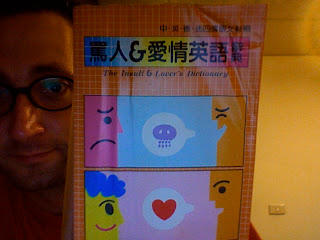 Part 1 is all about "letting 'em have it" (罵人 mà rén) and Part 2 is all about "sweet nothings to a sweet someone" (愛情的話 aìqíng de huà). The contents are divided topically, based on various settings and problems (traveling, eating, flirting, apologizing, etc.), which is pretty pedestrian. What makes this a real gem, is that each expression is provided in English, Chinese, German and French! So far I have found no egregious errors in either English or German, so I can surmise the Chinese and French are equally orthodox and vivid.
Part 1 is all about "letting 'em have it" (罵人 mà rén) and Part 2 is all about "sweet nothings to a sweet someone" (愛情的話 aìqíng de huà). The contents are divided topically, based on various settings and problems (traveling, eating, flirting, apologizing, etc.), which is pretty pedestrian. What makes this a real gem, is that each expression is provided in English, Chinese, German and French! So far I have found no egregious errors in either English or German, so I can surmise the Chinese and French are equally orthodox and vivid.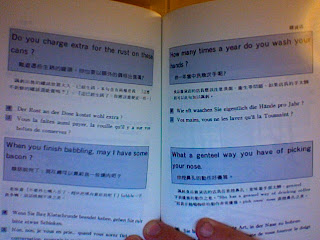 See? Chinese, English, German, and French––with pictures, too! Now I know I can read it!
See? Chinese, English, German, and French––with pictures, too! Now I know I can read it!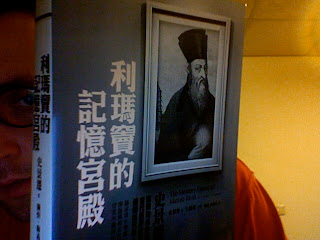 The last selection for the evening is a translation of Jonathan D. Spence's The Memory Palace of Matteo Ricci, which I treasure as one of my favorite books. Partially, I love the book because I have always taken Ricci as a personal role model: Catholic missionary, immersed in Western and Eastern wisdom, as well as profoundly averse in contemporary science and religion. It was a small grail-quest for me a couple years ago to reach the Jesuit Ricci Institute in Taipei and buy an annotated copy of Ricci's 天主實義 (Tiān Zhû Shíyì), The True Meaning of the Lord of Heaven. Ricci wrote this treatise in classical Chinese (!). It serves as a dual polemic against Buddhist apologetics against the Catholic faith and a broad apologetic of the Catholic Gospel in light of Asian tradition.
The last selection for the evening is a translation of Jonathan D. Spence's The Memory Palace of Matteo Ricci, which I treasure as one of my favorite books. Partially, I love the book because I have always taken Ricci as a personal role model: Catholic missionary, immersed in Western and Eastern wisdom, as well as profoundly averse in contemporary science and religion. It was a small grail-quest for me a couple years ago to reach the Jesuit Ricci Institute in Taipei and buy an annotated copy of Ricci's 天主實義 (Tiān Zhû Shíyì), The True Meaning of the Lord of Heaven. Ricci wrote this treatise in classical Chinese (!). It serves as a dual polemic against Buddhist apologetics against the Catholic faith and a broad apologetic of the Catholic Gospel in light of Asian tradition. Anyway, the other reason I love Spence's Memory Palace, is because I am fascinated by mnemonics and the neurology of memory. After reading The Memory Palace, I devised one of my favorite script concepts, tentatively titled "Who's Afraid of the Memory Palace of You Know Who?" I won't go into details here, but suffice to say "Who's Afraid…" is a "mnemonic thriller" about history, voyeurism, memory, possession, love, and regret. A sort of "Little Matchstick Girl" meets Memento meets One Hour Photo… meets Matteo Ricci's memory palace. As a matter of fact, Spence's book, or, rather, his presentation of Ricci's astounding mnemonic skills, inspired me to construct my own memory palace. It is based on the Japanese tea house in Kill Bill, Vol. 2 (you know, the one in which the Bride hacks all the baddies to blood-spurting bits of samurai sushi).
Anyway, the other reason I love Spence's Memory Palace, is because I am fascinated by mnemonics and the neurology of memory. After reading The Memory Palace, I devised one of my favorite script concepts, tentatively titled "Who's Afraid of the Memory Palace of You Know Who?" I won't go into details here, but suffice to say "Who's Afraid…" is a "mnemonic thriller" about history, voyeurism, memory, possession, love, and regret. A sort of "Little Matchstick Girl" meets Memento meets One Hour Photo… meets Matteo Ricci's memory palace. As a matter of fact, Spence's book, or, rather, his presentation of Ricci's astounding mnemonic skills, inspired me to construct my own memory palace. It is based on the Japanese tea house in Kill Bill, Vol. 2 (you know, the one in which the Bride hacks all the baddies to blood-spurting bits of samurai sushi). 
And heck, while I'm at doing a photo blog, here is me with my new little buddy, Amble. He was a shriveled, malnourished but spunky street puppy who started followed me one night, about a month ago, while I was walking home from school (long story…sigh…). I eventually lured him in with food and was able to grab his nape, whereupon, once he was done crying and trying to nip me, and had completely emptied his bladder onto my pants and shirt, I carried him home, showered him and, in time, de-flea'd and dewormed him. He's putting on some weight and growing all the time. Just last night he lost another baby tooth. He's only about 4 months old. I still need to get him the battery of dog vaccines, but the vet said we need to get him over a cold first and, well, since then I just haven't found the time to go back. Bad master! Amble is unbelievably tranquil and friendly; the only time he makes noise is when he is in pain or sees me walking away from him, as if for good, and he is tied up or held in somewhere. In Taiwanese they say that fortune is about to come your way after a dog follows you. Well, let's hope it's true! I'd like to think Amble is my own Santa's Little Helper.

1 comment:
Sweet finds, White Mountain. Hey, if you haven't gotten on Visual Bookshelf yet (on Facebook), you need to. You are one of my few friends I could greatly benefit from by seeing what you're reading. (I have catalogued every book I've read as an adult on there.)
Post a Comment